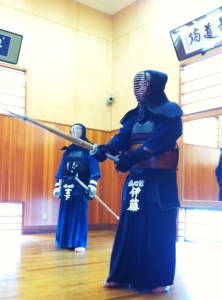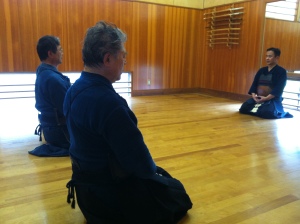Japanese martial arts have become popular around the world, but here in their home, they are not just sports, but art and philosophy as well. Two of our guides, Chiho and Emma, recently went to a kendo practice to learn more and to prepare to show our guests this fascinating martial art.
The teacher, Ito-sensei, has long experience and teaches everyone from children to adults who have themselves already reached the seventh dan (only one level from the top), making the sessions at his dojo fascinating to watch. In between conducing rigorous training, he kindly answered many of our questions.
Q. You seem to have several high-level students in your dojo. Is kendo strong in Niigata Prefecture?
A. Yes, it is. I think it flourished particularly in the former castle towns.
Q. How old is kendo?
A. It’s difficult to say exactly, but wooden swords were introduced during the Edo Period. Even then, however, people sometimes died during practice, and so now we use swords made of bamboo.
Q. How about your mask? Tell us about that.
A. These flaps are made of a kind of fibre that is compressed very hard, several centimetres of it, and then stitched to become firm. Women used to be employed to sew these by hand, but no longer. This mask was made in Japan, but the stitching was done overseas. The cheapest masks are entirely made overseas, but of course the quality is not the same. Nowadays, if you want a mask made in Japan from start to finish, you need to order it. The craftsman will measure your face and make it to fit you. The position of these bars across the front is particularly important: if they are at eye-level, you won’t be able to see out properly. There are few craftsman left, so it takes them several months to finish your mask: by the time it arrives, you’ve probably forgotten that you ordered it! I have had this mask for about thirty years, but I don’t use it every day; I use various different masks, so they last longer.

Q. Why do you slide your feet across the floor instead of walking normally?
A. Just before we strike, we lift up our foot. We need to be ready to strike at any time, so we usually keep both feet on the floor, to maintain our balance.
Q. When you’re hit, does it hurt?
A. A little bit, but not too much.
[One of the students looks unsure about this]
He thinks it does hurt! He always flinches before my sword hits him…

Q. When you are engaged in a practice bout, how do you decide when it is over?
A. The student will tell the teacher when he feels that he has reached the end of his strength. Younger practitioners will sometimes end with one last attack, but for older people like us, we tend to say when we want to stop.

Q. Kendo is popular overseas now. What do you think about this?
A. When Japanese martial arts become popular overseas, they become more widely-known, which is good; but at the same time, they have to change somewhat in order to become sports. “Sports” are about scoring points, winning and losing, but in kendo, the way someone moves is equally important. It’s about art, and about the way you concentrate your whole spirit. Other martial arts like karate have asked to be included in the Tokyo 2020 Olympics, but kendo has not volunteered; I think that this is the reason why.
I’ve sometimes been asked to go overseas to teach, but I’m too busy here…
Q. At the end of the session, after the students bow to you, you all turn and bow towards the front of the dojo, then towards the right. Who are you bowing to?
A. First we bow to our teachers who came before us, those who are no longer here. We acknowledge that there are greater teachers than us. Then we turn in the direction of the kamidana (the god-shelf), to pay our respects to the god of the dojo.

Guests to Itoigawa can watch these fascinating training sessions, try on the kendo gear, try out the moves and, if they have some prior experience, even join the practice! So why not experience kendo with an expert?
